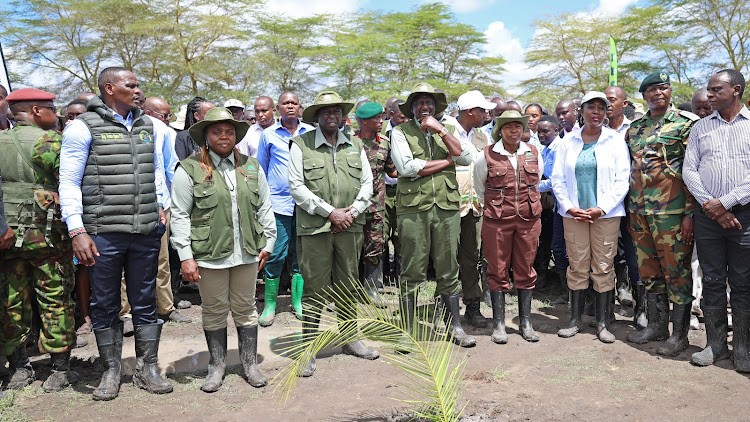15 Billion Trees, 580,367 km²: A Planting Puzzle in Kenya’s Landscape

President William Ruto presided over a nationwide tree-planting campaign on November 13th, now recognized as National Tree Planting Day. The President and the First Lady Rachel Ruto, joined the public in planting a remarkable 150,000 trees at Kiu Wetland in Makindu, Makueni County. Meanwhile, governors and cabinet secretaries spearheaded similar tree-planting initiatives across the remaining 46 counties, in an effort to improve Kenya’s Landscape and Ecosystem Restoration Programme, which seeks to grow 1.5 billion trees annually and 15 billion trees by 2032 – a target that is only nine years away.
According to Government Spokesperson Isaac Mwaura, over 150 million trees were planted at the end of the “Green Holiday” tree planting exercise. Mwaura stated at his first news conference on November 15 that over 10 million trees had been logged on the ‘Jaza Miti’ smartphone application, which helps keep track of the amount of trees grown and guides users on which tree species to grow in their various areas in Kenya.
Notably, some counties, like Makueni, set specific targets, with Governor Mutula Kilonzo Jnr pledging an impressive 344 million trees for a greener future – promising a whopping 34 million trees each year.

While planting trees is a positive step toward a more sustainable and vibrant future for the country, Kenyans are wondering if it is practical, reasonable and realistic to plant over 150 million trees on one day in a country with a population of 50 million or 15 billion trees on Kenya’s geographical of 580,367 land mass. To estimate the feasibility of planting 15 billion trees in Kenya, we would need to consider factors such as the spacing between trees, the types of trees chosen, and the land use patterns or activities. Land development activities involve a broad spectrum of human interventions, including residential, commercial, and industrial construction, infrastructure projects, agriculture, recreational spaces, mixed-use developments, mining, and the establishment of educational and institutional facilities – all of these developments sit on an unknown percentage of land in square kilometers.
Kenya has a total land area of approximately 580,367 square kilometers – this is inclusive of water bodies. Assuming an average spacing of 3 meters by 3 meters (9 square meters) per tree, the total land area required for planting 15 billion trees would be:
Total Land Area = Number of Trees X Spacing per Tree
Total Land Area = 15,000,000,000 Trees X 9 square meter/Tree
Total Land Area = 135,000,000,000 square meter
Converting this to square kilometers:
Total Land Area = 135,000 square kilometer
Given that Kenya’s total land area is approximately 580,367 square kilometers, it becomes evident that planting 15 billion trees with the specified spacing would far exceed the available land mass. This illustrates the need for a more realistic and sustainable approach, possibly involving a combination of afforestation, reforestation, and agroforestry practices, taking into account existing land use, ecological considerations, and community involvement.

But more important is the watchdog role of the media. The media plays a crucial role in ensuring transparency and accountability, not only in President Ruto’s ambitious 15 billion tree-planting initiative but also in addressing other matters of public interest or involving public resources. To verify the accuracy of the president’s statements on planting 15 billion trees and assess whether they align with realistic goals, media should engage in rigorous fact-checking, seeking input from environmental experts, forestry agencies, and other relevant stakeholders.
Investigative reporting should delve into the specifics of the plan, including the types of trees chosen, the proposed spacing, and the timeline for implementation.
Additionally, journalists should interrogate every statement made especially by public officials. They should scrutinize the availability of resources, funding commitments, and the extent of community involvement. By holding the government accountable through thorough and independent reporting, the media can contribute to ensuring that the tree-planting initiative is not merely a political promise but a viable and sustainable effort towards environmental conservation.